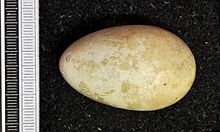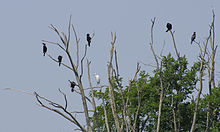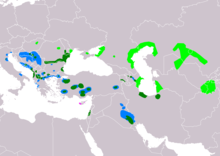Dwarf shark
| Dwarf shark | ||||||||||
|---|---|---|---|---|---|---|---|---|---|---|

Dwarf shark ( Microcarbo pygmeus ) |
||||||||||
| Systematics | ||||||||||
|
||||||||||
| Scientific name | ||||||||||
| Microcarbo pygmeus | ||||||||||
| ( Pallas , 1773) |
The dwarf shag ( Microcarbo pygmeus , Syn . : Phalacrocorax pygmeus ) belongs to the family of cormorants (Phalacrocoracidae).
Appearance
The dwarf shear is 45 to 60 cm long, weighs 700 g and has a wingspan of approx. 80 cm. It is dark in color with a dark red-brown head.
Diet and Lifestyle
The dwarf shark feeds mainly on the fish, which it hunts with targeted diving attacks. When swimming, dwarf shags keep looking down to spot a fish. They move under water with paddling movements of their feet. When surfacing, only their long necks appear above the surface. In flight, dwarf shags move with elongated necks and constantly flapping wings.
Reproduction

It breeds in trees or in the reeds and forms colonies that can consist of tens or hundreds of birds. Their eggs are greenish white and have a size of 60 × 36 mm. The young birds leave the nest before they can fly at around ten weeks old.

distribution and habitat
The distribution area of the dwarf shear stretches from the east of the Mediterranean area across Asia Minor to Uzbekistan. In North Africa, where this species originally also occurred, it has disappeared.
The dwarf shark is native to south-eastern Europe, it can be found in the lagoon all year round, e.g. B. Karavasta , on the entire Danube Delta and in some fish-rich lakes. It requires inland waters with dense bank vegetation such as reeds or alluvial forest and can be found on lakes, oxbow lakes, in swamps and on shallow steppe lakes. In winter, the birds can also be seen on the seashore and can then appear in large flocks. Dwarf shags prefer still waters and a mild climate.
Inventory and inventory development
The European breeding bird population is estimated at 28,000 to 38,000 breeding pairs. The main area of distribution is in Romania and Azerbaijan. Other larger populations can be found in the European part of Russia, Greece and Turkey. Central Europe lies on the north-western edge of the distribution area. The dwarf shag has resettled here in Hungary in recent years, and there have been new settlements in Slovakia. The European winter population is estimated at 63,000 to 115,000 individuals.
In 2001, more than 200 breeding pairs brooded again in Hungary. The dwarf shear is currently spreading north again, particularly along the Tisza and Danube. They may benefit from the eutrophication of the waters and the resulting increase in white fish stocks. In 2000 there was the largest winter population of this species in Bulgaria with 11,905 individuals, and now there are again 250 breeding pairs in Bulgaria. The first breeding settlements in Austria took place in 2003. In 2007, 14 pairs were counted in the reed belt of Lake Neusiedl , in 2009 there were already 77.
Individual evidence
- ↑ a b Hans-Günther Bauer, Einhard Bezzel and Wolfgang Fiedler (eds.): The compendium of birds of Central Europe: Everything about biology, endangerment and protection. Volume 1: Nonpasseriformes - non-sparrow birds . Aula-Verlag Wiebelsheim, Wiesbaden 2005, p. 240.
- ↑ Erwin Nemeth: Monitoring of the herons, spoonbills and dwarf shags of the Neusiedler See area in 2009 . In: Ornithological monitoring in the Neusiedler See National Park - Seewinkel , Vienna 2010, pp. 3–7.
literature
- Hans-Günther Bauer, Einhard Bezzel and Wolfgang Fiedler (eds.): The compendium of birds in Central Europe: Everything about biology, endangerment and protection. Volume 1: Nonpasseriformes - non-sparrow birds. Aula-Verlag Wiebelsheim, Wiesbaden 2005, ISBN 3-89104-647-2 .
Web links
- Picture at www.naturfoto-cz.de
- Videos, photos and sound recordings of Phalacrocorax pygmaeus in the Internet Bird Collection
- Micro Carbo pygmeus in the endangered Red List species the IUCN 2012. Posted by: BirdLife International, 2012. Accessed September 2, 2013.
- Feathers of the dwarf shark
